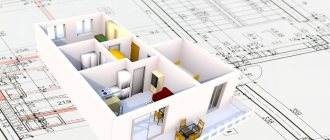Obligation to pay for the maintenance and repair of visual equipment in the apartment building
Management organizations issue invoices to the owners of non-residential premises for the maintenance and repair of the common property of apartment buildings. The owners of such premises refuse to pay the received payment documents, arguing that they do not have a contractual relationship with the management company.
By virtue of clause 2 of Art. 8.1 of the Civil Code of the Russian Federation, the right of ownership of property subject to state registration arises, changes and terminates from the moment the corresponding entry is made in the state register, unless otherwise provided by law.
The owner bears the burden of maintaining the property he owns (Article 210 of the Civil Code of the Russian Federation).
Common property in an apartment building belongs to the owners of the premises on the right of common shared ownership, in accordance with clause 1, part 1, art. 36 Housing Code of the Russian Federation. The common property of apartment buildings includes premises that are not parts of apartments and are intended to serve more than one room in such a building:
- inter-apartment landings;
- stairs;
- elevators;
- elevator and other shafts;
- corridors;
- technical floors;
- attics;
- basements with utility lines;
- other equipment serving more than one room.
Each participant in common shared ownership is obliged, in proportion to his share, to participate in the payment of taxes, fees and other payments on common property, as well as in the costs of its maintenance and preservation (Article 249 of the Civil Code of the Russian Federation).
Owners of premises in apartment buildings bear the burden of expenses for maintaining common property in an apartment building (Part 1 of Article 39 of the Housing Code of the Russian Federation).
In accordance with Part 2 of Art. 154 of the Housing Code of the Russian Federation, payment for residential premises and utilities of the owner of the premises in an apartment building includes payment for services and work on managing such a house, for the maintenance and ongoing repairs of common property in an apartment building, for utility resources consumed during the use and maintenance of public buildings in an apartment building.
The owner's obligation to pay maintenance and repair costs is not conditioned by the existence of a contractual relationship with the management organization. This conclusion can be found in paragraph 24 of the Review of judicial practice of application of the legislation of the Russian Federation on the contract system in the field of procurement of goods, works, services to meet state and municipal needs, approved by the Presidium of the Supreme Court of the Russian Federation on June 28, 2017.
By virtue of Part 2.3 of Art. 161 of the Housing Code of the Russian Federation and clause 10 of the Decree of the Government of the Russian Federation of August 13, 2006 No. 491, the performance of work and provision of services for the maintenance of the common property of an apartment building is mandatory for the management organization in accordance with the legislation of the Russian Federation. The MA cannot refuse to perform such work and provide services even if a state or municipal contract has not been concluded.
The fact that the owner of non-residential premises did not take action to conclude a contract to fulfill the obligation to bear expenses for common property does not relieve him of the obligation to pay the appropriate fee.
Thus, the owner of a non-residential premises located in an apartment building, by virtue of the direct instructions of the law, is obliged to bear the costs of maintaining the common property, unless otherwise provided by law or contract.
Debt collection in the housing and communal services sector
By what signs can you identify the premises of an HOA?
What is it? The premises of an HOA should include objects that are on its balance sheet, but are not in the personal possession of members of the organization. The premises belong to the partnership if it:
- is not part of the apartment of any of the residents;
- used for the purpose of servicing several common real estate objects;
- used for placement of utilities.
There is a clear distinction between the property of homeowners and the property of the housing association. Residents are not responsible with their property for the unlawful use of common property, and the premises of the HOA can be disposed of through a general meeting.
Debt collection from owners of non-residential premises
Owners of non-residential premises in apartment buildings are required to pay for housing and communal services according to the same rules as owners of residential premises. The management organization may require the owner of non-residential premises to promptly pay fees for the maintenance and repair of the common property of an apartment building.
If the owner of a non-residential premises refuses to pay the management organization for the maintenance and repair of common property, you should first try to resolve the issue amicably and explain to the owner of the non-residential premises why he is obligated to pay for the maintenance and repairs of the residential premises: send debt payments, letters or try to conclude an agreement about debt repayment.
If the owner refuses to pay the bills, the management company should proceed to pre-trial debt collection: before filing an application to the court, the debtor must submit a claim demanding payment of the debt on a voluntary basis. According to Part 5 of Art. 4 of the Arbitration Procedure Code of the Russian Federation, the debtor is obliged to respond to such a claim within 30 calendar days.
If the debtor refuses or does not respond to the claim at all, the management organization may file a claim in court. The Arbitration Court considers such applications. But it happens that disputes reach the Supreme Court of the Russian Federation.
An example of such a dispute is given in the ruling of the Supreme Court of the Russian Federation dated November 28, 2017 in case No. 305-ES17-10430. In it, the court indicated that the management organization can recover the debt for the maintenance and repair of common property from the owner of non-residential premises.
How to register partial repayment of debt for housing and communal services
How to conclude an agreement for the rental of common areas?
To receive additional income from renting out common premises, you must:
- determine a list of HOA premises that can be rented out;
- set future rents;
- present a lease project at the general meeting;
- after the project is approved by vote, search for potential tenants;
- conduct negotiations with tenants and conclude agreements;
- register the lease agreement with the Rosreestr authorities.
First of all, it is necessary to check the premises that are on the balance sheet of the housing association, their condition and documentation. It is important to make sure you have:
- cadastral passport;
- technical plan;
- a document evidencing the HOA's ownership of the property.
In the absence of the last document, it will be impossible to rent out any space. If the empty property is located on the territory of the HOA, but does not belong to it, then it is necessary to register rights to it by applying with the available documents for these areas to the Rosreestr authorities.
The documents must be accompanied by a certificate from the cadastral chamber about the boundaries of land plots adjacent to the houses of the housing association.
IMPORTANT! If, after the creation of a partnership, part of the premises located on its territory has signs of common property, but continues to be used by third parties, the board has the right to force such persons to vacate the premises or set a rent.
After preparing the premises, it is necessary to conduct marketing research that will help determine the average market rental price for objects of this type and the seasonal dynamics of this cost.
Next, you should draw up a plan for receiving rental income and distributing it to the needs of the organization. The plan also includes the costs of advertising the premises for rent, legal services, etc.
To draw up a lease agreement, it is better to take a standard agreement and change it to suit specific circumstances. It is mandatory to indicate in the contract:
- data and details of the parties to the transaction;
- parameters of the rental property;
- subject and general terms of the agreement;
- rent amount;
- liability for non-compliance with conditions.
At the meeting, a project of economic activity from leasing premises should be presented, listing the expected income and areas for its use (for example, to pay off debts to resource suppliers or to improve the territory).
The general meeting can either approve the amount of rent and conclude an agreement with a specific tenant or advertiser, or entrust this activity to the board, an engaged manager or a contractor (in the case of large housing associations with a large number of premises for rent).
REFERENCE! In most housing associations, at a general meeting, upper and lower limits for the amount of rent are adopted, within which the board sets a price for a specific tenant based on the results of negotiations.
This measure is necessary to protect owners of common property from reckless actions of the board, without convening a meeting to sign each agreement.
If the contract is concluded for a period of one year or more, it must be registered with the Rosreestr authorities. To register, a member of the board who has entered into an agreement should contact Rosreestr with the following documents:
- copy of the passport;
- a copy of the lease agreement;
- registration application;
- receipt of payment of state duty.
The agreement is registered within five working days. In order not to register a rental agreement, it must be concluded for a period of 11 months or less.
For the legality of the income received, the chairman of the housing association or his accountant must annually, before the beginning of April, submit a report on the rental income received to the tax service and pay income taxes.
What are the justifications for utility tariffs?
Determining utility tariffs is the prerogative of local governments, which justify them using independent expert data. For consumer settlements with resource supplying organizations, these values are used only after their approval by a special energy commission accredited by the State Construction Committee of the Russian Federation.
In the cost of utilities, a significant share is made up of the cost of purchased energy resources. To provide heat supply services, the percentage of costing items is as follows:
- costs for different types of fuel – about 35%;
- costs for used electrical energy ≈ 9–10%;
- salary costs (with deductions) – about 15%.
The structure of costs for water supply is expressed, respectively, by values of ≈ 20%, 18–20%, 15%. It also includes a revenue component, which for all utilities is set at approximately 5%.
The main reason for increasing utility tariffs is the increase in prices for gas, electricity, water, and heat, which is the result of an increase in inflation. Tariff revisions, according to federal law, should occur no more than once a year.
Procedure for providing services
According to the norms of Resolution No. 354, the services of supplier organizations are provided from the time the property rights of the owners of non-residential areas are recognized. Their composition depends on the degree of improvement of the apartment building and includes:
- electrical supply;
- supply of gas, water (cold and hot);
- drainage;
- collection of solid waste (solid waste).
With the exception of heat supply, which is provided only during the cold season, all other services are provided year-round.
IMPORTANT! The basis for the provision of certain public services is a paid agreement with resource-providing entities.
Such a document between the communal organization and the owner of the non-residential area in the apartment building must be in writing. In the absence of an agreement, the supply of services is carried out on the basis of calculations made by the resource supplying organization itself (based on Resolution No. 1498 of December 26, 2016).
Calculation of the amount
When calculating the amount paid for services consumed during the month, the tariffs of the supplying organization are applied. Calculation of resource consumption comes down to using a formula in which the monthly recurring value is the tariff (price per unit of resource). The variable quantity is the amount of resource consumed.
For hot and cold water
The constantly changing value is determined using common household or individual devices. Thus, by simply multiplying the above values, the payment amounts for gas, hot and cold water, recycled waste, and electricity consumed in a commercial premises are calculated:
P = V x T, where:
- P – amount in rubles to be reimbursed for services used.
- V is the amount of resource consumed during the estimated time.
- T – tariff.
For heating
The amount to be paid monthly for heating (if metering devices are not installed in the non-residential area or house) is determined by multiplying three factors:
P = S x N x T, rub, where
- total area of non-residential premises (S);
- standard value of heating consumption (N);
- established tariff (T).
Depending on the frequency of payment for heating services - year-round or throughout the heating season - a coefficient to the consumption standard (K) is used. It is determined by dividing the heating season time (in months) by the number of months in the year, i.e. by the number 12.
P = S x (N x K) x T, rub.
Who makes payments and how?
According to paragraph 65 of Chapter. 6 of Resolution 354, the consumer of services can independently pay for them, or can instruct other persons to pay by any means that do not contradict the requirements of legislative acts and the concluded agreement.
If the owner of the premises provides it for rent, then responsibility for paying for housing and communal services still remains with the owner of the property.
You can pay expenses immediately, or you can pay them in installments, but you cannot violate the deadline for payment of utilities established by the contract. The consumer has the right to make prepayments for future billing periods.
How does the procedure differ from that for a residential property?
The owner of a non-residential property is obliged to enter into direct contracts with resource supply organizations.
If the object is located in a non-residential building, then its owner is not obliged to contribute funds for major repairs. In the absence of an agreement for the maintenance of the local area with the management company, this expense item is also not payable. But the owner of the premises will have to maintain and maintain the adjacent territory independently.
To connect utility resources, the owner of a non-residential property must enter into contracts directly with providers of these services. In addition, the owner of the property will have to bear the burden of maintaining common premises, although he does not actually use them.
There is one way to avoid this expense item - to buy premises in a non-residential building. But then you will have to independently organize the cleaning of the surrounding areas and the maintenance of technical premises in a usable condition.
How to pay?
You can pay for utilities in any convenient way, unless otherwise stated in the concluded agreement (clause 65 of Chapter 6 of Resolution 354). You can pay:
- in branches of banking institutions;
- in Internet banking systems;
- in post offices;
- payment terminals, etc.
Payment can be made in cash and by bank transfer, by postal transfers or by bank card, on the Internet and in other forms provided for by current legislation. The payment document must be kept for at least three years from the date of payment.
On our Internet portal you will find other articles about the rules for the use and ownership of non-residential real estate, namely:
- How to draw up a flood report?
- How to conclude an agreement with an office cleaner?
- What are the nuances of maintenance and resource supply?



